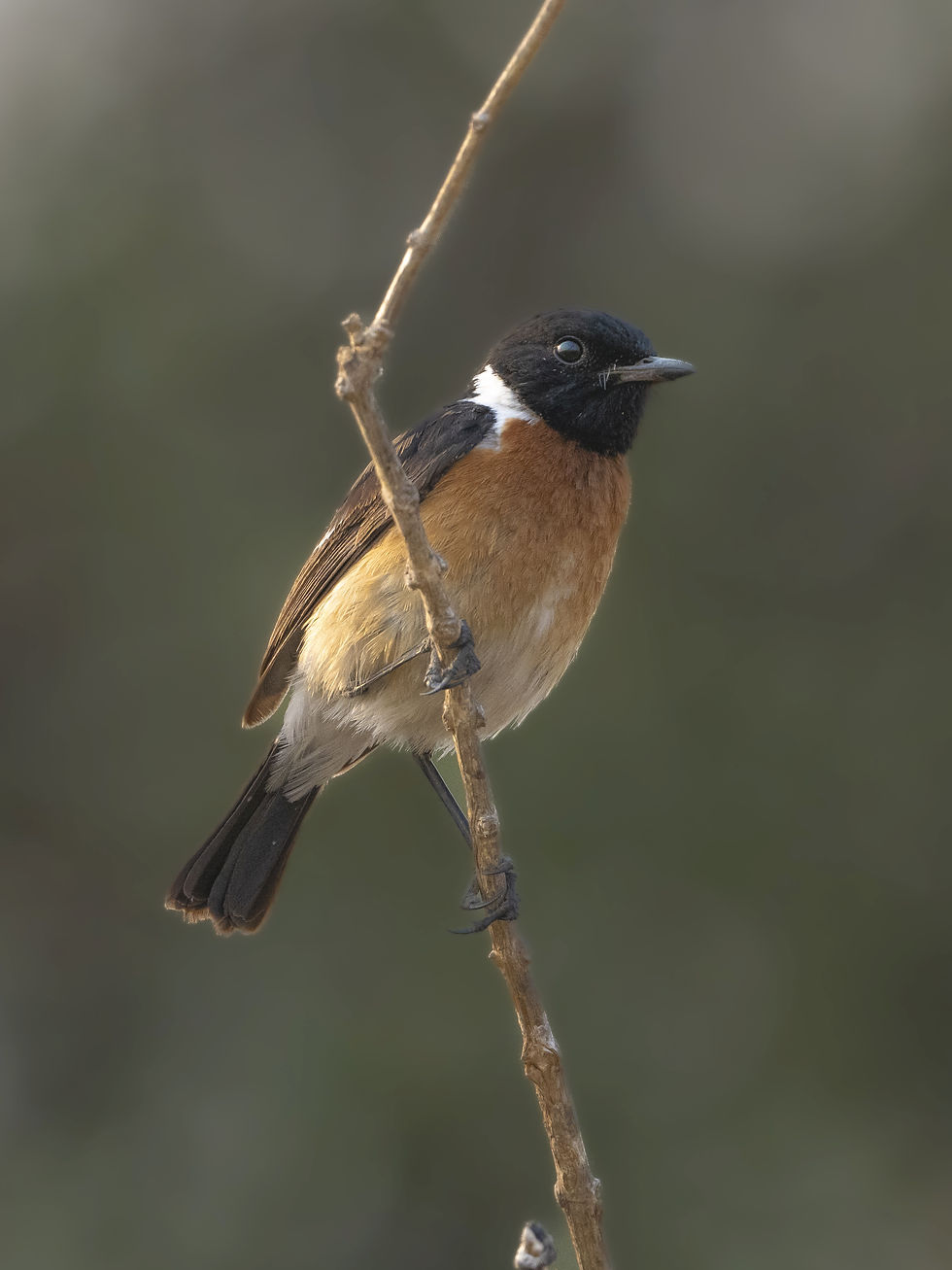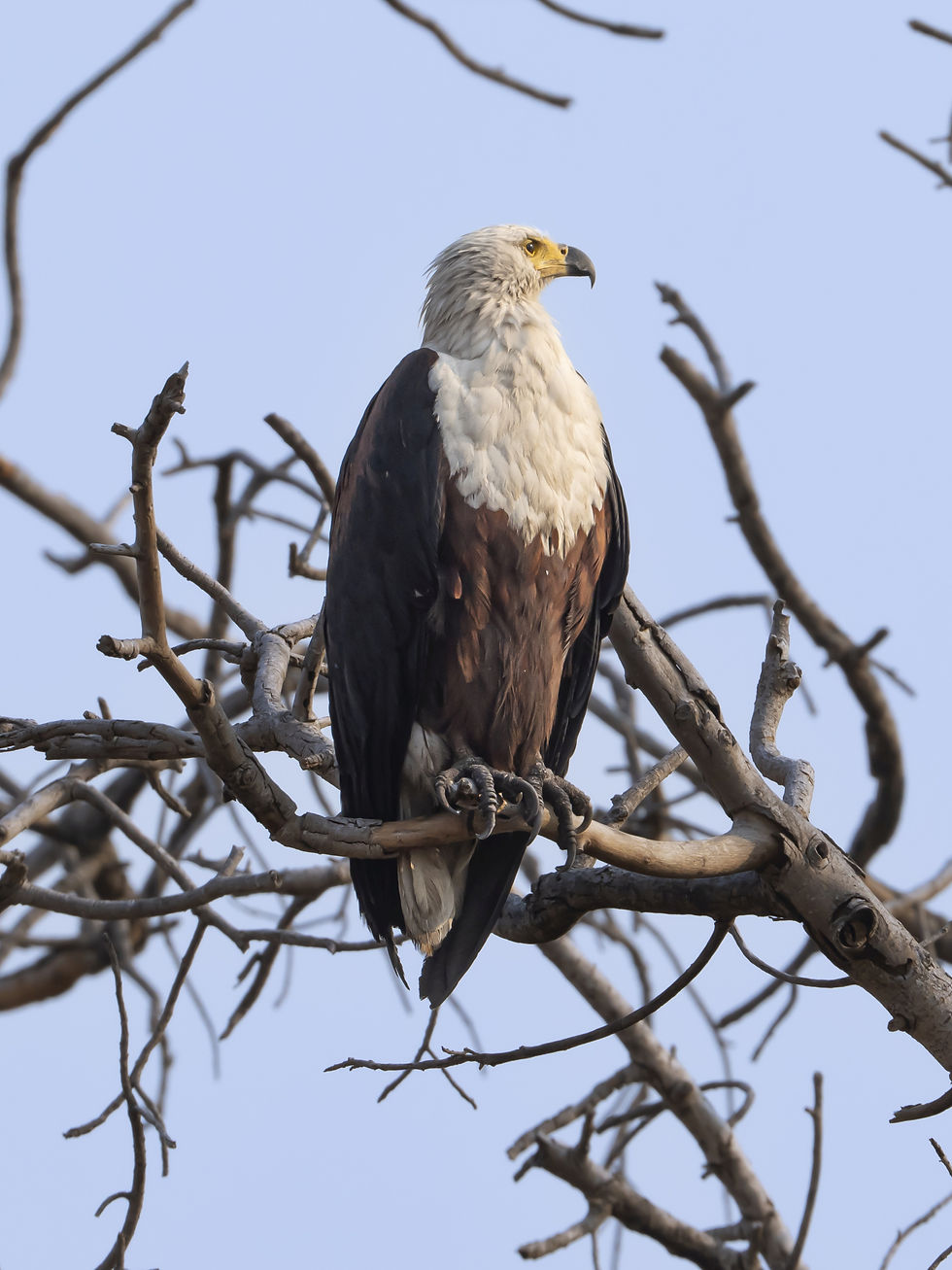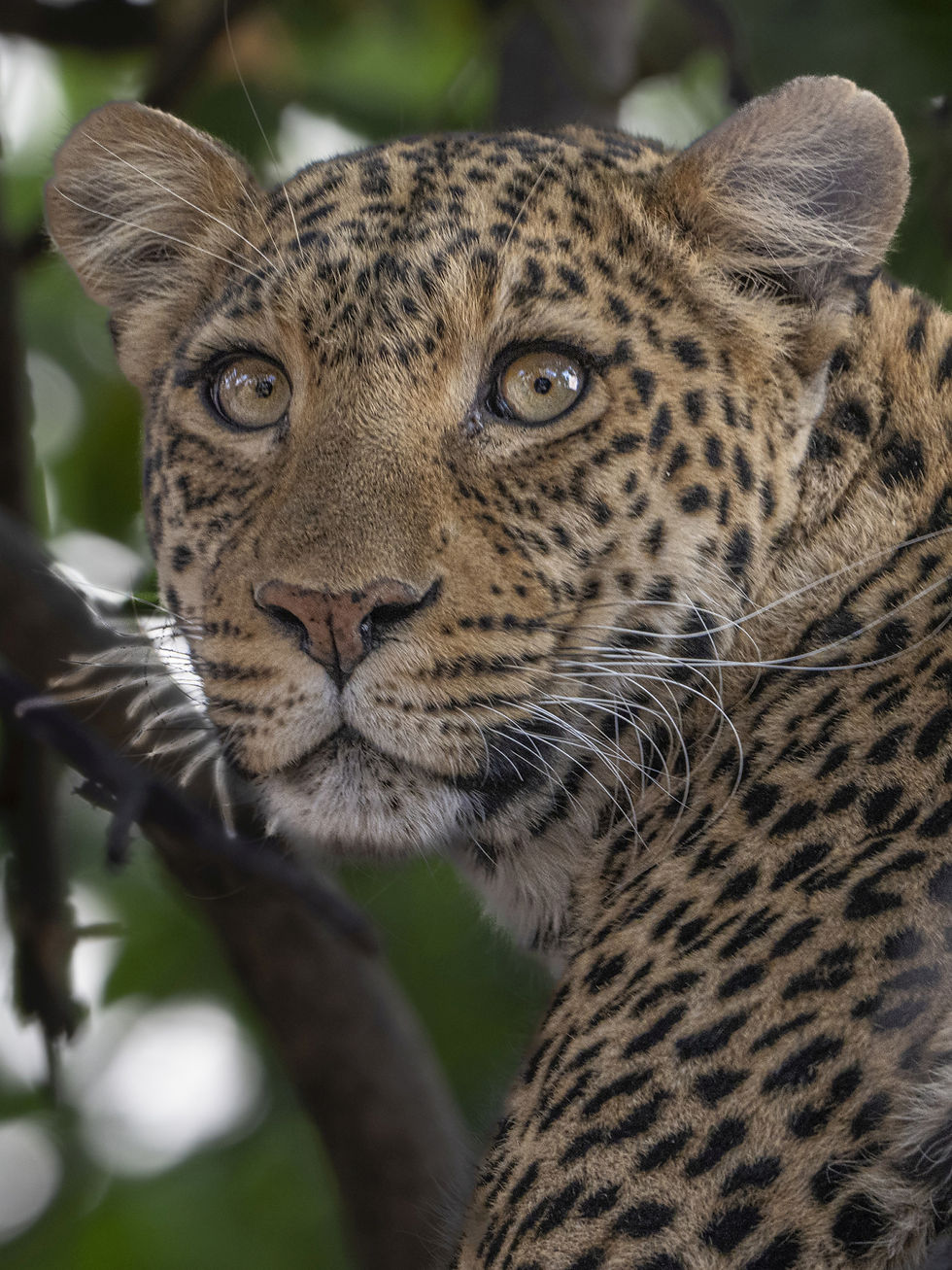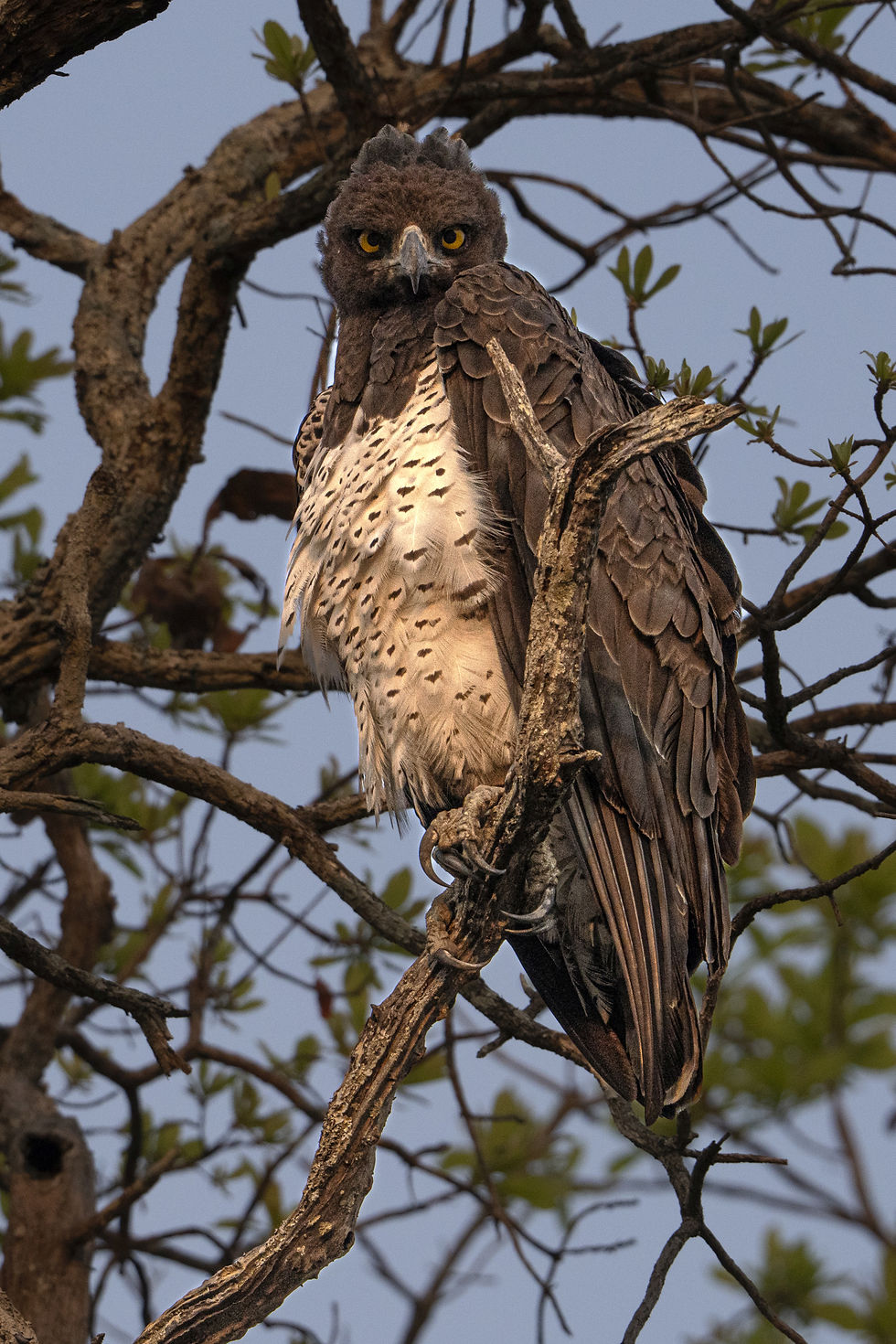In the North of Kafue National Park, Zambia
- Ueli Huber
- Oct 21, 2023
- 9 min read
Updated: Jul 8, 2024

All pictures in all of the blogs from Zambia and Malawi are joint works
© Brigitte and Ueli Huber
Location: In the North of Kafue National Park, Zambia (https://www.kafuenationalparkzambia.com/ - unfortunately information is a bit limited)
Camp/Lodge: Chisa Busanga Camp, Green Safaris (www.greensafaris.com)
Wir brachten ein grosses Stück Weg hinter uns vom Lower Zambezi in den Kafue National Park im Nordwesten Sambias. Mit einer Fläche von über 22'000 Quadratkilometern ist letzterer fast halb so gross wie die Schweiz! Unser Camp befand sich ganz im Norden des Parks, bei den Busanga Plains. Wieso die so heissen, wird beim Landeanflug rasch klar: Die Landschaft ist flach (mit lockerem Baumbestand), so weit das Auge reicht. Hier oben ist kein Fluss in der Nähe. Es hat zwar die eine oder andere Lagune, aber kaum mehr Wasser. Der Boden ist hartgetrocknet (was man nach einer Weile auch auf den Safaritours merkt). Die Unterschiede in Flora und Fauna zum Lower Zambezi fallen rasch auf. Man sieht es auch den Fotos an: Viel Gelb, von trockenem Gras, oder das Olivebraun der fast trockenen Lagunen, kaum Grün, ausser an den Bäumen. Der Vogelreichtum ist aber gross: wir sahen in diesem Park etwa 80 Vogelarten. Ebenso leben hier verschiedene Arten von Antilopen. Zu ihnen gehört das abgebildete Puku (Grasantilope), eine mittelgrosse Antilopenart.

It was a long way from the Lower Zambezi to the Northern Kafue National Park in Zambia’s Northwest. With an area of over 22'000 square kilometers, the latter is almost half the size of Switzerland! Our camp was located in the very north of the park, at the Busanga Plains. Why they are called plains becomes obvious during the landing approach: The landscape is flat (with loose trees) as far as the eye can reach. Up here, there is no river nearby. There is the odd lagoon, but hardly any water. The ground is hard-dried (which you notice after a while on the safari vehicles). The differences in flora and fauna compared to the Lower Zambezi are quickly noticeable. You can see it in the photos, too: Lots of yellow, from dry grass, or olive brown of the almost dry lagoons, hardly any green, except on the trees.However, the abundance of birds is huge: we saw about 80 species of birds in this park. Likewise, several species of antelopes live here. Among them is the pictured Puku, a medium sized antelope species.
Die Gabelracke kam praktisch an jeder unserer Stationen vor. Sie gehört zu den farbenprächtigsten Vögeln, denen wir in Afrika begegnet sind. Sie sind wirklich so farbig, wie das auf der Aufnahme aussieht. Der Kupferschwanzkuckuck gehört, wie sein Name sagt, zur Familie der Kuckucksvögel, von denen wir auch ein paar andere Arten sahen, die in späteren Blogs vorkommen werden. Sie gehören aber einer anderen Gattung an als der im Sommer bei uns weilende Kuckuck, und das rote Auge ist ein typisches Merkmal für sie.

The Lilac-breasted Roller was present at practically every one of our stations. It is one of the most colorful birds we encountered in Africa. These birds are really as colorful as it looks on the picture. The Coppery-tailed Coucal, as its name suggests, belongs to the cuckoo bird family, of which we also saw a few other species that will feature in later blogs. However, they belong to a different genus than the cuckoo that stays with us in summer, and the red eye is a typical feature for them.

Wir begegneten an diesem ersten Nachmittag auch nochmals einem Löwen. Er hielt sich etwas versteckt. Offenbar handelte es sich um einen Eindringling ins Revier, der sich vor den dominanten Männchen in Acht nehmen musste. Diese befanden sich aber an diesem Tag weit entfernt am anderen Ende des Reviers bei der Familie.

We also encountered a lion again that first afternoon. He was hiding a bit. Apparently it was an intruder into the territory, which had to be careful of the dominant local males. However on this day they were far away at the other end of their territory with the family.
Der «Sundowner» gehört nun einfach einmal zum Safarileben: ein Drink irgendwo draussen, mit schönem Ausblick, meist auf den Sonnenuntergang, bevor es dann in der (oft spannenden) Dunkelheit ins Camp zurückgeht. Die Engländer trinken bei dieser Gelegenheit noch immer am liebsten Gin and Tonic, was mich ein bisschen an Somerset Maugham und Hemingway erinnerte (The Short and Happy Life of Francis Macomber).

The "sundowner" is simply part of safari life: a drink somewhere outside, with a beautiful view usually of the sunset, before returning to camp in the (often exciting) darkness. The English still prefer to drink gin and tonic on this occasion, which reminded me a bit of Somerset Maugham and Hemingway (The Short and Happy Life of Francis Macomber).
Am nächsten Tag ging es wie üblich um sechs los. Wir stiessen auf eine reiche Auswahl an Tieren, nachdem wir erst einmal die in der Ferne sprintende Hyäne verfolgt und auch gefunden hatten. Die drei Weissrückengeier (IUCN*: Vom Aussterben bedroht) scharten sich um ein altes Skelett, wo nichts mehr zu holen war. Auch ein Streifenschakal und eine Afrikanische Rohrweihe sahen sich in der Gegend um.


The next day we started at six as usual. We encountered a rich assortment of animals, after first tracking and also finding the hyena sprinting in the distance. The three White-backed Vultures (IUCN*: Critically Endangered) were clustered around an old skeleton where nothing could be found. A Side-striped Jackal and an African Marsh Harrier were also looking around in the area.


Wir stutzten ein bisschen, als wir das junge Afrikanische Schwarzkehlchen sahen, das von seiner Mutter gefüttert wurde. Schliesslich war ja Ende September. Aber wir befanden uns natürlich auf der Südhalbkugel, wo es schon langsam vom Frühling in den Frühsommer ging.

We were a bit perplexed when we saw the young African Stonechat being fed by its mother. After all, it was late September. But, of course, we were in the southern hemisphere where it was already slowly going from spring to early summer.

Beim adulten Männchen sieht man im übrigen die Zugehörigkeit zur Familie der Fliegenschnäpper und insbesondere die nahe Verwandschaft mit dem in Europa anzutreffenden Schwarzkehlchen sehr gut.
In the adult male, by the way, one can see very well the relation to the family of Old World Flycatchers and especially the close relationship with the European Stonechat.

Wie im letzten Blog erwähnt, war der Schreiseeadler ein steter Begleiter. Hier in den Busanga Plains waren zwei von ihnen spielerisch unterwegs. Der Jungvogel hielt irgend ein Beutestück in den Krallen, das ein Altvogel ihm streitig machen wollte. Ein dritter, vermutlich ebenfalls ein Elternteil, sass auf dem Baum, unter dem wir parkiert hatten, direkt über uns.

As mentioned in the last blog, the Lesser Spotted Eagle was a constant companion. Here in the Busanga Plains, two of them were out playfully. The young bird was holding some prey in its claws that an adult bird was trying to steal from it. A third one, probably also a parent, was sitting on the tree under which we had parked, directly above us.


Die Kronenkraniche (IUCN: Gefährdet) zieren schon das Titelbild. Ebenfalls anwesend, aber in grosser Distanz (und dann wegfliegend) waren zwei Klunkerkraniche, von denen es leider, leider keine Aufnahmen gibt (IUCN: Verletzlich).


The Grey Crowned Cranes (IUCN: Endangered) already adorn the cover picture. Also present, but at a great distance (and then flying away) were two Wattled Cranes, of which there are unfortunately no photographs (IUCN: Vulnerable).
Mit diesen Vögeln im Blick machten wir denn auch für die ebenfalls obligate morgendliche Teepause Halt. Da gibt es aber tatsächlich Tee oder Kaffee, ohne Zusatz! Wir konnten mit der Tasse in der Hand die im Winter aus Europa hierher fliegenden Rotflügelbrachschwalben und auch ein paar kleinere Vögel wie den auch in Südeuropa vorkommenden Zistensänger beobachten. Das Vögelchen ist ein Standvogel, der eine relativ grosse Verbreitung in der alten Welt hat. Ganz anders der Rubinkehlpieper, der ein verhältnismässig kleines Verbreitungsgebiet in Afrika hat, v.a. in Sambia und Botswana. Er gehört zur grossen Familie der Stelzen und Pieper.

With these birds in view we stopped for the obligatory morning tea break. But there is actually tea or coffee, without anything added! With the cup in our hands we could observe the Collared Pratincoles flying here from Europe in winter and also a few smaller birds like the Zitting Cisticola, which is also found in southern Europe. The little bird is a resident bird, however, that has a relatively wide distribution in the Old World. Quite different is the Rosy-throated Longclaw, which has a relatively small range in Africa, especially in Zambia and Botswana. It belongs to the large family of Wagtails and Pipits.


Die Pferdeantilope – tatsächlich verwandt mit dem Pferd – hat ebenfalls ein sehr kleines Verbreitungsgebiet. Man trifft sie nur im nördlichen Sambia an, wo wir sie gesehen haben, und im westlichen Zimbabwe.
The Roan Antelope - related to the horse - also has a very small range. It is only found in northern Zambia, where we saw it, and in western Zimbabwe.

Ob man den Leoparden antrifft oder nicht, ist dann eher Glücksache - in Zambia vielleicht etwas weniger als anderswo: die Dichte an Leoparden ist gross. Und wir hatten hier in den Busanga Plains erneut Glück. Wir waren alleine unterwegs, als unser Führer die Katze entdeckte – wir fragen uns immer noch wie, sie war so gut versteckt. Der Leopard liess sich von uns nicht stören, auch nicht, als wir unsere Position etwas verbesserten, und hielt still für ein ausgiebiges Fotoshooting aus naher Distanz.

Whether you encounter the leopard or not is rather a matter of luck - in Zambia maybe a little less than elsewhere, as the density is very high. And we were lucky again here in the Busanga Plains. We were alone when our guide spotted the cat - we still wonder how, it was so well hidden. The leopard was not disturbed by our presence, not even when we improved our position a bit, and kept still for an extensive photo shoot from close distance.

Und am nächsten Morgen, dem letzten hier, ging schon wieder ein Wunsch in Erfüllung! Den Kampfadler (der Name scheint berechtigt) hatten wir vor fünf Jahren nur aus weiter Distanz gesehen. Hier sass er auf einem Baum und liess unsere Aufmerksamkeit geduldig über sich ergehen. Dies ist der grösste Adler Afrikas. Das Weibchen kann über sechs Kilogramm schwer werden, und der Vogel kann auch schon einmal ein junges Impala oder Warzenschwein «pflücken». Auf der roten Liste der IUCN wird er als Gefährdet geführt. Wir mussten allerdings etwas leiden für diese Aufnahmen. Der Vogel befand sich auf einem Baum in einer Gegend, in der es auch viele Miombo-Bäume gab. Und die sind ein bevorzugter Aufenthalt der Tsetse-Fliegen. Sie sind zwar in dieser Gegend keine Krankheitsträger, aber ihre Bisse schmerzen eklig und lang.

And then the next morning, the last in Kafue, another wish came true! We had seen the Martial Eagle (the name seems justified) five years ago only from far away. Here it sat on a tree and patiently endured our attention. This is the largest eagle in Africa. The female can weigh over six kilograms, and these birds can easily grab a young Impala or Warthog. It is listed as Endangered on the IUCN Red List. However, we had to suffer a bit for these shots. The bird was on a tree in an area where there were also many Miombo trees. And these are a preferred residence of Tsetse flies. They are not disease carriers in this area, but their bites hurt nastily and for quite a while.

Die letzte Fahrt im Kafue Nationalpark bescherte uns schliesslich auch den einzigen Geparden, den wir auf dieser Reise sahen. Die anderen Camps lagen nicht in Gegenden mit geeignetem Geparden-Terrain.

The last drive in the Kafue National Park finally brought us the only Cheetah we saw on the whole trip. The other camps were not in areas with suitable cheetah terrain.
Und schliesslich: So entstehen Legenden! Auf der Fahrt zum Flugfeld am nächsten Morgen fotografierte ich dieses Einhorn. Es handelt sich bei dem weggaloppierenden Tier um eine weibliche Rappenantilope, der irgendwann ihr zweites Horn abhandengekommen ist. Auf ihr reiten zwei Madenhacker mit. Ihre Aufgabe ist es, Huftiere (von den Giraffen und Zebras über Flusspferde und allerlei Antilopen) von Ungeziefer zu befreien.

And finally: This is how legends are made! On the drive to the airstrip the next morning, I photographed this unicorn. The animal galloping away is a female Zevo, or Sable Antelope, which lost its other horn at some point. Two Oxpeckers are riding along. Their job is to remove vermin from the backs of giraffes, zebras, hippos and all sorts of antelopes.
_______________________________________________________
Der lange, äusserst unruhige Flug in einer kleinen Cessna in südöstlicher Richtung nach Mfue war nicht lustig. Es rüttelte und schüttelte während zwei Stunden. Ich bin eigentlich sehr resistent und nehme nie ein Medikament gegen Reiseübelkeit. Diesmal hätte es sich gelohnt. Mir war speiübel, als ich in Mfue aus der Maschine stieg. Wir waren froh, dass es nun per Safarikarren ins nächste Camp ging.
The long, extremely bumpy flight in a small Cessna to Mfue in the Southeast was no fun. It shook and shook for two hours. I am actually very resistant and never take any medication against travel sickness. This time it would have been worth it. I was sick to my stomach when I got off the plane in Mfue. We were glad that it was now by safari cart to the next camp.
*IUCN: See the International Union for Conservation of Nature's Redlist of Endangered Species ((https://www.iucnredlist.org/)
Weckt Erinnerungen ....
Geniale pics, vielen Dank! LG Tom, immer noch an der Wärme